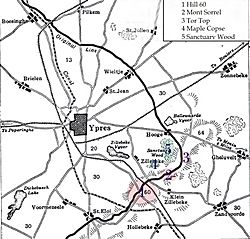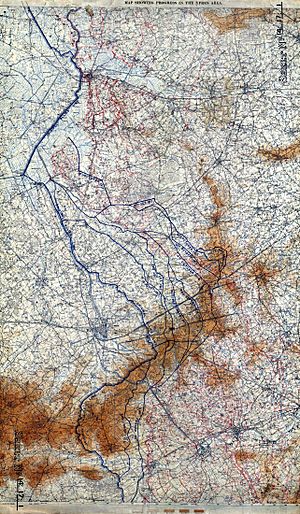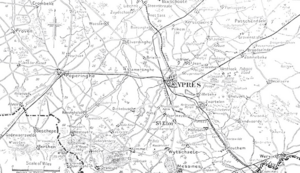Actions of the Bluff, 1916 facts for kids
Quick facts for kids The Bluff |
|||||||||
|---|---|---|---|---|---|---|---|---|---|
| Part of the First World War | |||||||||
 The Bluff, St Eloi |
|||||||||
|
|||||||||
| Belligerents | |||||||||
| Commanders and leaders | |||||||||
| Erich von Falkenhayn | Douglas Haig | ||||||||
| Strength | |||||||||
| 2 regiments | 2 brigades | ||||||||
| Casualties and losses | |||||||||
| 14–18 February: 329 2 March: 908 |
14–17 February: 1,294 2–4 March:1,622 |
||||||||
The Actions of the Bluff were small battles fought during the First World War in 1916. These fights happened in a place called Flanders, in Belgium. The German army and the British army were involved.
The Bluff was a large mound of earth near a town called St Eloi, south-east of Ypres. It was made from dirt dug out when the Ypres–Comines Canal was built before the war. From February 14 to 15, and again on March 2, 1916, the Germans and British fought hard for control of this mound. The Germans first captured it, but the British fought back and took it again.
These battles at the Bluff were part of several small attacks made by both sides. The British army, led by Sir Douglas Haig, was in a tough spot. Their positions were on low, wet ground, which the Germans could easily see. Instead of staying quiet, the British kept fighting, and many German attacks were in response to British ones.
The German army had better weapons and could move their soldiers and equipment more easily. They also had many experienced officers and soldiers. British volunteer soldiers learned a lot during these smaller battles. In the underground war, British tunnel builders became very skilled. Capturing enemy trenches was possible, but holding them was much harder. For example, when the British captured the Bluff, the Germans tried to take it back.
Contents
What Was the Bluff?
The Ypres Area
Ypres is a town in Belgium. It is surrounded by hills. Kemmel Hill is to the south-west, and other hills like Hill 60 and [[Passchendaele (Passendale)]] are to the east. These hills are not very high, but they are important because whoever controls them can see far across the flat land around Ypres. This gives them a big advantage in battle.
Controlling the higher ground meant armies could see where the enemy was, aim their cannons better, and move their own soldiers and supplies without being seen. The hills had woods like Polygon Wood, which offered good cover. The roads were mostly dirt, and the land was a mix of fields and meadows with many streams and ditches.
The Bluff Itself
The Bluff was a large pile of dirt created when the Ypres–Comines Canal was dug. This canal connected two river valleys. The Bluff was about 30 feet (9 meters) high. It had a steep side facing west and a gentler slope to the east. It was one of the best places to see the surrounding area in the Ypres Salient (a bulge in the front lines).
The British front line was just east of the Bluff. The space between the British and German lines, called "no man's land," was about 150 yards (137 meters) wide. In some places, it was as narrow as 40 yards (37 meters).
Underground Warfare
In 1915, there was a lot of underground fighting in the Ypres area, including at the Bluff. Both sides dug tunnels and placed mines. British tunnel builders, called "tunnellers," were very busy.
In late 1915, the Germans blew up two mines near the canal. In January 1916, the Germans exploded an even bigger mine. This created a large crater about 100 yards (91 meters) wide. The British quickly took control of this crater and turned it into a defensive position. The British tunnellers then worked to build their own tunnels to stop the Germans from trying again. This was very difficult because the ground was wet and loose.
Getting Ready for Battle
German Plans
The Germans were planning a huge battle called the Battle of Verdun. To distract the British and French, they ordered their armies in Flanders to make smaller attacks. From February 8 to 19, 1916, the German Fourth Army attacked several times around Ypres. They would fire their cannons and then send in their soldiers.
On February 14, the Germans attacked near Hooge and Sanctuary Wood. The German commander, General Watter, ordered a careful attack on the Bluff. Some German generals thought the Bluff would be easy to capture but hard to hold.
British Preparations
The British Second Army did not know exactly what the Germans were planning. British planes tried to scout the area, but bad winter weather made it hard. They reported that a big German attack seemed unlikely.
The British V Corps held the front line from St Eloi to Hooge. The 17th (Northern) Division was in charge of the area around the Ypres–Comines Canal, including the Bluff. The only way to cross the canal was a small wooden bridge far behind the front lines. Only a small group of British soldiers held the Bluff itself.
On February 13, new soldiers and equipment arrived for the British. On the morning of February 14, the Germans began firing their heavy cannons at the British lines. By late afternoon, the shelling became very intense. The British soldiers on the Bluff took cover in a tunnel.
The Battle Begins
February 14–16
By 5:45 p.m., the British front defenses were destroyed. A German mine exploded, burying most of the soldiers in the tunnel at the Bluff. The German Infantry Regiment 124 (IR 124) attacked along a half-mile front. By 6:05 p.m., the British front line was captured. By 6:32 p.m., the Germans had taken almost all their targets, including the Bluff.
Some German soldiers pushed further but were stopped by the British. The British tried to counter-attack immediately, but there was confusion, and their attacks failed. They fought with hand grenades through the night.
By 7:30 a.m. on February 15, the Germans held the Bluff and the nearby British trenches. The British commanders realized that small counter-attacks would not work. They decided they needed a bigger, planned attack to take back the Bluff. General Plumer gave this job to the 76th Brigade, who knew the area well. This brigade, with extra artillery and engineers, began to prepare a new front line. The ground was very damaged by shelling and full of old trenches. The Bluff was surrounded by the canal and a stream, making the ground swampy.
February 17 – March 1
The 76th Brigade planned to attack the lost trenches at dusk, to have the most time to secure the area. Both sides kept firing their cannons. The German soldiers suffered heavy losses. From February 20 to 22, a new German regiment, Grenadier Regiment 123 (GR 123), took over. They found their defenses destroyed and had to hide in shell-holes, standing in water up to their waists.
The 76th Brigade rested and prepared for the attack. They were given new steel helmets. They practiced on a model of the German positions, made from air photos. The British also worked hard to dig new trenches, bury telephone cables, and bring up supplies.
Bad weather, including snow, slowed down the work. The snow made the new trenches easy to see. The attack was delayed until March 2. The ground became very muddy. The British commanders decided on a plan: they would fire their cannons until dusk, then stop. The attacking soldiers would move up overnight, and then attack after a 90-minute cannon bombardment at dawn.
On March 1, the British fired a very heavy bombardment from 5:00 to 5:45 p.m. They made it seem like they were attacking. Then, they waited to see how the Germans would react. The British planned to capture more than they had lost, by digging a new line. They brought up many different types of mortars (small cannons) to hit areas that bigger cannons could not reach. Air observation showed that most German defenses on the Bluff were destroyed.
March 2
The British attackers moved forward at 4:15 a.m. and attacked at 4:30 a.m. The artillery began firing behind the German lines, taking the Germans by surprise. Only on the left side did a German machine gun cause problems. The British soldiers easily walked over the remaining wire.
At the Bluff, the German guards were found hiding, expecting the usual pause before the artillery fired again. The rest of the German soldiers were in underground shelters. To the north, the British quickly took their targets. Some Germans who were bypassed later surrendered, and 181 prisoners were taken. On the left, the British captured the machine-gun nest by 5:10 a.m. They took 252 prisoners in total, with 47 from the Bluff resisting until evening.
British raiders blew up a German tunnel in no man's land. The German artillery began firing back at 9:30 a.m., but the British had already moved their soldiers out of the front line and were quickly digging in. The German artillery continued firing heavily until 3:15 p.m., causing much damage. One trench was named "International Trench" because dead soldiers from three different armies were found there.
The German GR 123 regiment was exhausted by the 36-hour British bombardment. In the evening, German soldiers tried to counter-attack. But the British had many Mills grenades (hand bombs) and machine guns, and they were able to push the Germans back. Each British attacker had carried two grenades, and 52,000 more were nearby.
What Happened Next?
Soldiers Lost
| Month | Total |
|---|---|
| December | 5,675 |
| January | 9,974 |
| February | 12,182 |
| March | 17,814 |
| April | 19,886 |
| May | 22,418 |
| June | 37,121 |
| Total | 125,141 |
From February 14 to 17, the British 17th (Northern) Division lost 1,294 soldiers, with 311 missing. From March 2 to 4, the attacking British battalions lost 1,622 soldiers. The German Infantry Regiment 124 lost 75 killed, 229 wounded, and 25 missing from February 14 to 18. On March 2, the Germans lost 908 soldiers, with Grenadier Regiment 123 losing 41 killed, 172 wounded, and 321 missing.
Later Battles
The Germans continued to dig long tunnels under the Bluff. On July 25, 1916, they blew a mine under the ridge. But the Canadian tunnel builders had warned the British, and Canadian soldiers quickly took over the crater before the Germans arrived.
Mining and tunnel warfare continued at the Bluff. After a German prisoner drew a map of their tunnels, the British dug a deep system under the German lines. On December 11, several large camouflets (mines that destroy enemy tunnels without breaking the surface) were set off. The British captured the German tunnels, making the area safe from German mining.
On June 7, 1917, the Germans were pushed out of the area during the Battle of Messines Ridge. The Germans took the Bluff back during their Spring Offensive in 1918. It changed hands for the last time on September 28, 1918, after an attack by the British 14th (Light) Division.
Remembering The Bluff
Today, the wooded ridge where the Bluff was is a nature reserve and picnic area called Provinciaal Domein Palingbeek. There are three Commonwealth War Graves Commission (CWGC) war cemeteries in the area where soldiers who died in the battles are buried:
- 1st DCLI Cemetery, The Bluff
- Hedge Row Trench Cemetery
- Woods Cemetery
Images for kids







